jump start SAAB 9-3 2007 Owners Manual
[x] Cancel search | Manufacturer: SAAB, Model Year: 2007, Model line: 9-3, Model: SAAB 9-3 2007Pages: 304, PDF Size: 26.16 MB
Page 6 of 304

6Engine bay, 4-cylColor code______________ 293
Engine number __________ 293
Gearbox number _________ 293
Warning labels __________ 8
Vehicle identification number 293Alternator_______________ 216
Drive belt _______________ 216
Exhaust emission control __ 155
Ignition system __________ 286
Simple troubleshooting (ACC) 268
Spark plugs _____________ 286
Turbo gauge ____________ 88Engine oil: checking level __ 207Automatic transmission _________ 163
Transmission: technical data _____ 287
Manual transmission ___________ 162
Battery ______________________ 213
Battery charge ________________ 213
Jump starting _________________ 198
Engine: description ____________ 202
Engine: technical data __________ 283
Important considerations for driving 154
Oil grade and viscosity__________ 284
Topping-up fluid _________ 218
Wash/wipe stalk switch____ 101
Washer fluid ____________ 218
Washer jets ____________ 218
Power steering ________________ 212
Fluid: checking/topping up _______ 212
Coolant: checking/topping-up ____ 209
Driving in hot climates __________ 187
Radiator _____________________ 283
Temperature gauge ____________ 88
Changing a fuse _________ 234
Fuse table _____________ 239
Fuses _________________ 234
Relays ________________ 239ABS brakes_____________ 170
Brake pads _____________ 211
Brake system ___________ 289
Brake fluid______________ 211
93_U S _M 07.book Page 6 W ednesday, April 12, 2006 9:30 AM
ProCarManuals.com
Page 7 of 304
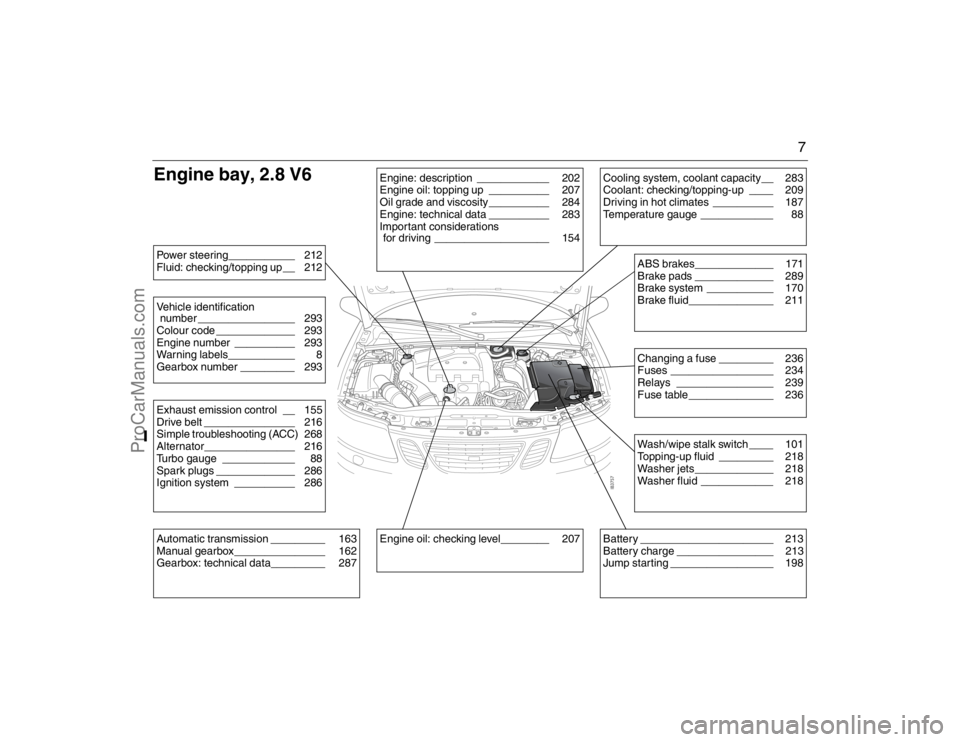
7
Engine bay, 2.8 V6Power steering___________ 212
Fluid: checking/topping up__ 212Vehicle identification
number ________________ 293
Colour code _____________ 293
Engine number __________ 293
Warning labels___________ 8
Gearbox number _________ 293Exhaust emission control __ 155
Drive belt _______________ 216
Simple troubleshooting (ACC) 268
Alternator_______________ 216
Turbo gauge ____________ 88
Spark plugs _____________ 286
Ignition system __________ 286Automatic transmission _________ 163
Manual gearbox_______________ 162
Gearbox: technical data_________ 287
Engine: description ____________ 202
Engine oil: topping up __________ 207
Oil grade and viscosity__________ 284
Engine: technical data __________ 283
Important considerations
for driving ___________________ 154Engine oil: checking level________ 207
Battery ______________________ 213
Battery charge ________________ 213
Jump starting _________________ 198
Wash/wipe stalk switch ____ 101
Topping-up fluid _________ 218
Washer jets_____________ 218
Washer fluid ____________ 218Changing a fuse _________ 236
Fuses _________________ 234
Relays ________________ 239
Fuse table ______________ 236ABS brakes_____________ 171
Brake pads _____________ 289
Brake system ___________ 170
Brake fluid______________ 211
Cooling system, coolant capacity__ 283
Coolant: checking/topping-up ____ 209
Driving in hot climates __________ 187
Temperature gauge ____________ 88
93_U S _M 07.book Page 7 W ednesday, April 12, 2006 9:30 AM
ProCarManuals.com
Page 149 of 304
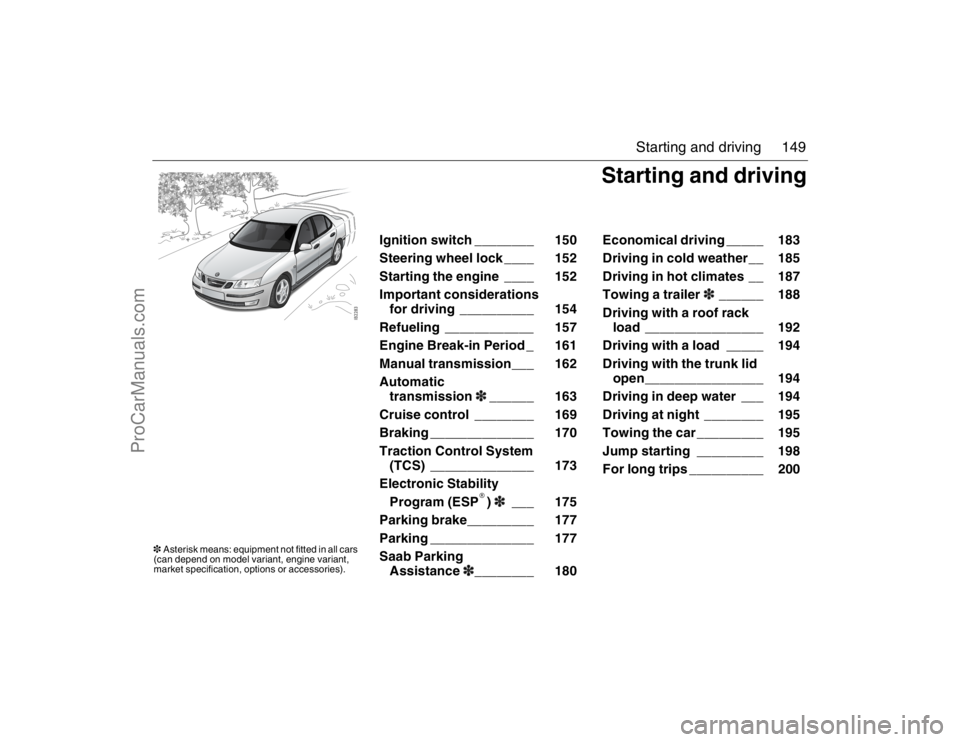
149 Starting and driving
Ignition switch ________ 150
Steering wheel lock ____ 152
Starting the engine ____ 152
Important considerations
for driving __________ 154
Refueling ____________ 157
Engine Break-in Period _ 161
Manual transmission___ 162
Automatic
transmission3______ 163
Cruise control ________ 169
Braking ______________ 170
Traction Control System
(TCS) ______________ 173
Electronic Stability
Program (ESP
®)3___ 175
Parking brake_________ 177
Parking ______________ 177
Saab Parking
Assistance3________ 180 Economical driving _____ 183
Driving in cold weather__ 185
Driving in hot climates __ 187
Towing a trailer3______ 188
Driving with a roof rack
load ________________ 192
Driving with a load _____ 194
Driving with the trunk lid
open________________ 194
Driving in deep water ___ 194
Driving at night ________ 195
Towing the car _________ 195
Jump starting _________ 198
For long trips __________ 200
Starting and driving
3Asterisk means: equipment not fitted in all cars
(can depend on model variant, engine variant,
market specification, options or accessories).93_U S _M 07.book Page 149 W ednesday, April 12, 2006 9:30 AM
ProCarManuals.com
Page 152 of 304
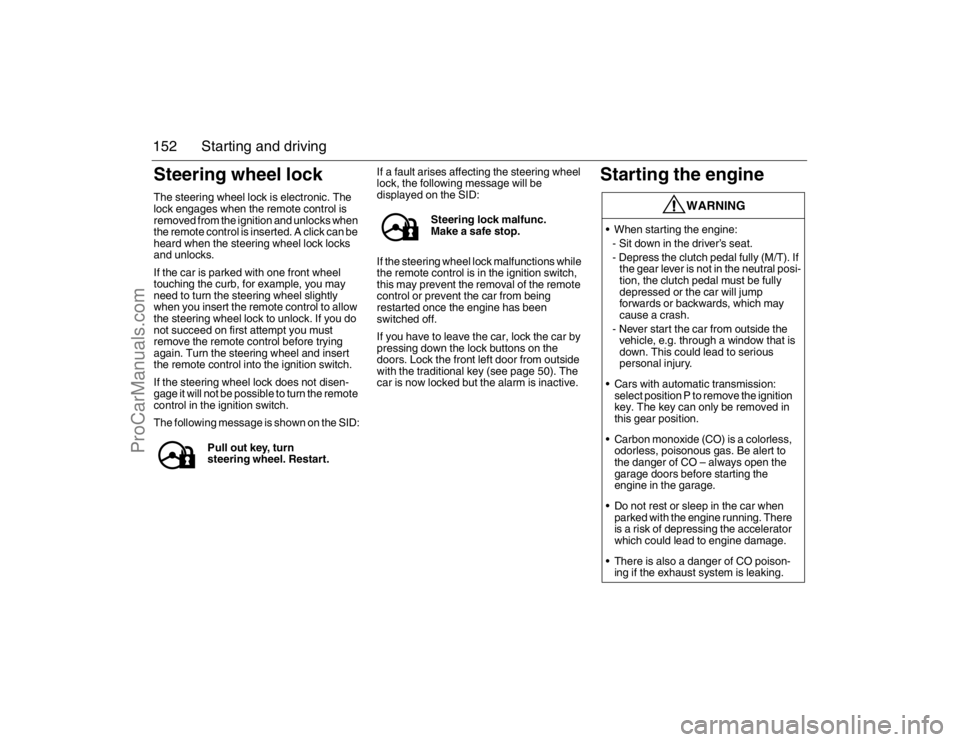
152 Starting and drivingSteering wheel lockThe steering wheel lock is electronic. The
lock engages when the remote control is
removed from the ignition and unlocks when
the remote control is inserted. A click can be
heard when the steering wheel lock locks
and unlocks.
If the car is parked with one front wheel
touching the curb, for example, you may
need to turn the steering wheel slightly
when you insert the remote control to allow
the steering wheel lock to unlock. If you do
not succeed on first attempt you must
remove the remote control before trying
again. Turn the steering wheel and insert
the remote control into the ignition switch.
If the steering wheel lock does not disen-
gage it will not be possible to turn the remote
control in the ignition switch.
The following message is shown on the SID:If a fault arises affecting the steering wheel
lock, the following message will be
displayed on the SID:
If the steering wheel lock malfunctions while
the remote control is in the ignition switch,
this may prevent the removal of the remote
control or prevent the car from being
restarted once the engine has been
switched off.
If you have to leave the car, lock the car by
pressing down the lock buttons on the
doors. Lock the front left door from outside
with the traditional key (see page 50). The
car is now locked but the alarm is inactive.
Starting the engine
Pull out key, turn
steering wheel. Restart.
Steering lock malfunc.
Make a safe stop.
WARNING
When starting the engine:
- Sit down in the driver’s seat.
- Depress the clutch pedal fully (M/T). If
the gear lever is not in the neutral posi-
tion, the clutch pedal must be fully
depressed or the car will jump
forwards or backwards, which may
cause a crash.
- Never start the car from outside the
vehicle, e.g. through a window that is
down. This could lead to serious
personal injury.
Cars with automatic transmission:
select position P to remove the ignition
key. The key can only be removed in
this gear position.
Carbon monoxide (CO) is a colorless,
odorless, poisonous gas. Be alert to
the danger of CO – always open the
garage doors before starting the
engine in the garage.
Do not rest or sleep in the car when
parked with the engine running. There
is a risk of depressing the accelerator
which could lead to engine damage.
There is also a danger of CO poison-
ing if the exhaust system is leaking.
93_U S _M 07.book Page 152 W ednesday, April 12, 2006 9:30 AM
ProCarManuals.com
Page 156 of 304

156 Starting and driving Have the car serviced regularly in accor-
dance with the service program.
Always be alert to any misfiring of the
engine (not running on all cylinders) and
any loss of power or performance. At the
first sign of a malfunction, reduce speed
and take the car to a workshop. We
recommend that you contact a Saab
dealer.
If the engine fails to start (in severe cold
or if the battery is flat), the car can be
bump started (manual transmission only)
or started using jump leads to a donor
battery. However, as soon as you have
started the engine, it is important that it
runs on all cylinders. If it is misfiring, allow
it to idle for up to 5 minutes to give it time
to settle and run smoothly. If, after this
time, the engine still fails to run properly,
switch off the engine to avoid serious
damage to the catalytic converter. We
recommend that you contact a Saab
dealer for advice. Never park the car on dry grass or other
combustible material. The catalytic
converter gets very hot and could there-
fore start a fire.
Never drive off if the engine is misfiring.
If you bump start the car when the engine
is already at normal working temperature,
the engine must start to run on all cylin-
ders. Abort bump starting if the engine
fails to start immediately.
Failure to strictly follow these instructions
can result in damage to the catalytic con-
verter and associated components, and
could represent a breach of the warranty
conditions.
NOTICEIf the car runs out of gas, air may be drawn
in with the fuel, which, in turn, can cause
the catalytic converter to be damaged by
overheating.
WARNING
If the engine is being run with the car on a
rolling road or dynamometer, to ensure
adequate cooling, air must be blown into
the engine compartment and under the
car at a rate equivalent to the ram-air
effect that would obtain at the corre-
sponding road speed.
Engine management system with catalytic
converter1 Engine control module
2 Oxygen sensor
3 Catalytic converter
93_U S _M 07.book Page 156 W ednesday, April 12, 2006 9:30 AM
ProCarManuals.com
Page 197 of 304
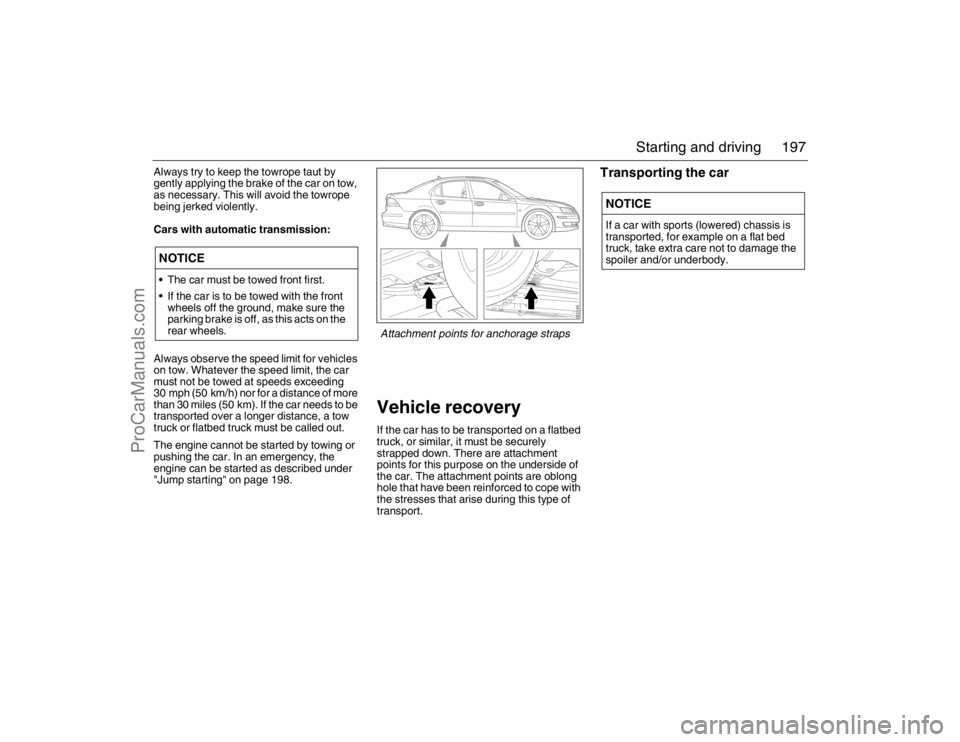
197 Starting and driving
Always try to keep the towrope taut by
gently applying the brake of the car on tow,
as necessary. This will avoid the towrope
being jerked violently.
Cars with automatic transmission:
Always observe the speed limit for vehicles
on tow. Whatever the speed limit, the car
must not be towed at speeds exceeding
30 mph (50 km/h) nor for a distance of more
than 30 miles (50 km). If the car needs to be
transported over a longer distance, a tow
truck or flatbed truck must be called out.
The engine cannot be started by towing or
pushing the car. In an emergency, the
engine can be started as described under
"Jump starting" on page 198.
Vehicle recoveryIf the car has to be transported on a flatbed
truck, or similar, it must be securely
strapped down. There are attachment
points for this purpose on the underside of
the car. The attachment points are oblong
hole that have been reinforced to cope with
the stresses that arise during this type of
transport.
Transporting the car
NOTICE The car must be towed front first.
If the car is to be towed with the front
wheels off the ground, make sure the
parking brake is off, as this acts on the
rear wheels.
NOTICEIf a car with sports (lowered) chassis is
transported, for example on a flat bed
truck, take extra care not to damage the
spoiler and/or underbody.
Attachment points for anchorage straps
93_U S _M 07.book Page 197 W ednesday, April 12, 2006 9:30 AM
ProCarManuals.com
Page 198 of 304
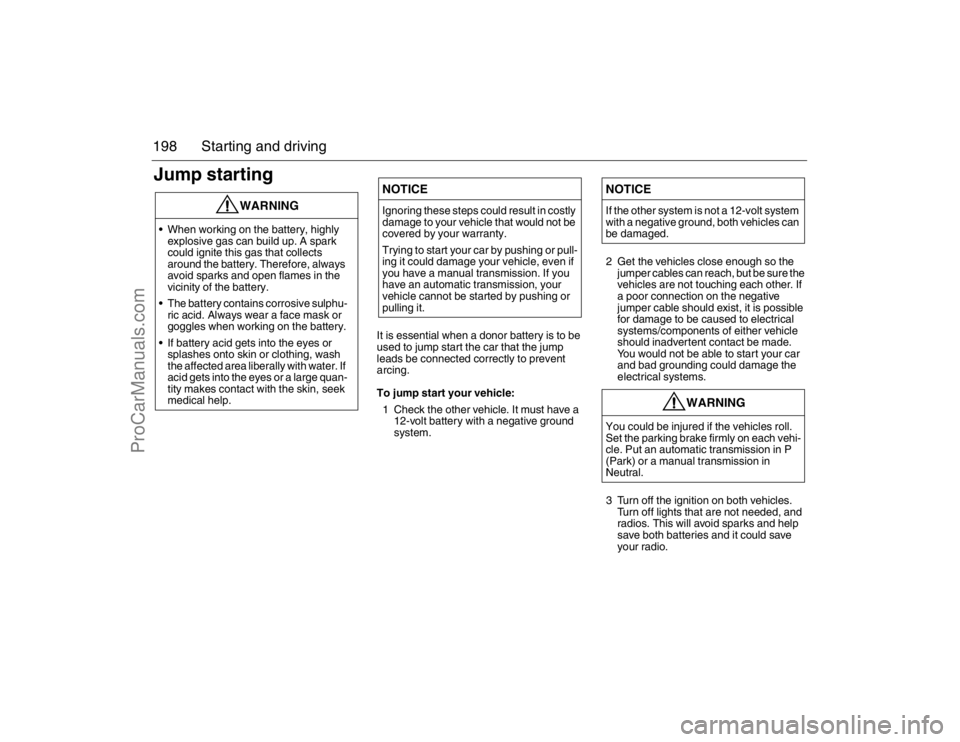
198 Starting and drivingJump starting
It is essential when a donor battery is to be
used to jump start the car that the jump
leads be connected correctly to prevent
arcing.
To jump start your vehicle:
1 Check the other vehicle. It must have a
12-volt battery with a negative ground
system.2 Get the vehicles close enough so the
jumper cables can reach, but be sure the
vehicles are not touching each other. If
a poor connection on the negative
jumper cable should exist, it is possible
for damage to be caused to electrical
systems/components of either vehicle
should inadvertent contact be made.
You would not be able to start your car
and bad grounding could damage the
electrical systems.
3 Turn off the ignition on both vehicles.
Turn off lights that are not needed, and
radios. This will avoid sparks and help
save both batteries and it could save
your radio.
WARNING
When working on the battery, highly
explosive gas can build up. A spark
could ignite this gas that collects
around the battery. Therefore, always
avoid sparks and open flames in the
vicinity of the battery.
The battery contains corrosive sulphu-
ric acid. Always wear a face mask or
goggles when working on the battery.
If battery acid gets into the eyes or
splashes onto skin or clothing, wash
the affected area liberally with water. If
acid gets into the eyes or a large quan-
tity makes contact with the skin, seek
medical help.
NOTICEIgnoring these steps could result in costly
damage to your vehicle that would not be
covered by your warranty.
Trying to start your car by pushing or pull-
ing it could damage your vehicle, even if
you have a manual transmission. If you
have an automatic transmission, your
vehicle cannot be started by pushing or
pulling it.
NOTICEIf the other system is not a 12-volt system
with a negative ground, both vehicles can
be damaged.
WARNING
You could be injured if the vehicles roll.
Set the parking brake firmly on each vehi-
cle. Put an automatic transmission in P
(Park) or a manual transmission in
Neutral.
93_U S _M 07.book Page 198 W ednesday, April 12, 2006 9:30 AM
ProCarManuals.com
Page 199 of 304

199 Starting and driving
4 Open the hood and locate the battery.
Find the positive (+) and negative (–) termi-
nals on the battery.5 Check that the jumper cables do not
have loose or missing insulation. If they
do, you could get a shock and also the
vehicles could be damaged.
Before you connect the cables, here are
some basic things you should know.
Positive (+) will go to positive (+) and
negative (–) will go to negative (–). Do
not connect (+) to (–) or you will get a
short that could injure you or would
damage the battery and maybe other
parts as well.
6 Connect the red positive (+) cable to the
positive (+) terminal of the vehicle with
the discharged battery.7 Do not let the other end touch metal.
Connect it to the positive (+) terminal of
the good battery. Use a remote positive
(+) terminal if the vehicle has one.
8 Now connect the negative (–) cable to
the good battery’s negative terminal.
9 Attach the cable to the discharged
battery’s negative terminal.
10 Start the vehicle with the good battery
and run the engine for a while.
11 Try to start the vehicle with the
discharged battery. If it does not start
after a few tries, it probably needs
service.
Note. If the current in the low battery is
too low it might be necessary to wait
several minutes with the cables
connected before you can start the
engine with the low battery.
12 Remove the cables in reverse order to
prevent electrical shorting. Take care
that they do not touch each other or any
other metal.NOTICEIf you leave your radio on, it could be
badly damaged. The repairs would not be
covered by your warranty.
WARNING
An electric fan can start up even when the
engine is not running and can injure you.
Keep hands, clothing and tools away from
any underhood electric fan.
WARNING
Using a match or flame of any kind near a
battery can cause battery gas to explode.
You can suffer burns or be blinded. Use a
flashlight if you need more light.
Be sure the electrolyte in the battery is not
frozen. Discharged batteries will freeze.
When connecting jumper cables to a
frozen battery, gas from the chemical
reaction inside the battery can build up
under the ice and cause an explosion.
Battery fluid contains acid that can burn
you. Do not get it on you. If you acciden-
tally get it in your eyes or on your skin,
flush the area with water and get medical
help immediately.
Jump starting93_U S _M 07.book Page 199 W ednesday, April 12, 2006 9:30 AM
ProCarManuals.com
Page 200 of 304

200 Starting and drivingUsing a battery charger3/starter
unitTo avoid damaging the car’s electrical
system and electronics, the following rules
must be followed when charging the battery
or jump starting the car.
If the charger or starter unit can be set to
different voltages (6V/12V/18V/24V), 12V
must be selected.
Follow the manufacturer’s instructions
supplied with the charger or starter unit.
No other apparatus that are grounded or
connected to the mains must be
connected to the car during charging or
jump starting.
The charger or starter unit must under no
conditions produce a voltage greater
than:
16V continuous
18V for 60 min.
If you are unsure about the charge rating of
the unit, disconnect the battery clamp from
the positive terminal before connecting the
unit to the battery.
For long tripsBefore starting off on a long journey, it is
advisable to have your car inspected by
your Saab dealer.
Obtain a few important items to take along
on your journey, such as spare bulbs, wiper
blades, fuses, a drive belt (poly-V-belt) and
the like.
You can check some points yourself before-
hand:
Check that no oil or fuel leaks out of the
engine or gearbox/transmission.
Check the coolant and power steering
fluid levels. Check also for leaks.
Inspect the drive belt (poly-V-belt) and
replace if it shows any signs of wear.
Check the battery charge.
Check the tires for tread pattern and air
pressure, including the compact spare
tire.
Take an extra remote control and keep it
separate.
Check the brakes.
Check all bulbs.
Check for the presence of the tool kit and
jack in the car.
93_U S _M 07.book Page 200 W ednesday, April 12, 2006 9:30 AM
ProCarManuals.com
Page 301 of 304

301 Index
Headlight flasher
________________ 100
Headlight levelling ________________ 99
Headlights
______________________ 99
Hood
_________________________ 204
Horn _________________________ 120
Horn button
____________________ 120
IIf a tire goes flat
________________ 250
Ignition switch
__________________ 152
Immobilizer
_____________________ 57
Important considerations for driving
_ 156
Important information, petrol-engined
cars with catalytic converters
_____ 157
Indicator lights
___________________ 84
Inflation, tires __________________ 243
Information about fuel
____________ 161
Instrument illumination, adjusting
___ 100
Interior lighting, Convertible
________ 80
Interior lighting, Sport Sedan and
SportCombi
___________________ 133
Interior rearview mirror
___________ 125
Intermittent malfunctioning, central
locking
_______________________ 52
JJump starting
__________________ 200
KKey
___________________________ 50
Kick-down
_____________________ 166
LLATCH (child safety)
______________ 25
Labeling, tire sidewall ____________ 251
Labels and plates, location
________ 293
Lashing eyes, Sport Sedan ________ 141
Lashing eyes, SportCombi ________ 146
Laying the car up
_______________ 181
Leather upholstery, cleaning
_______ 263
Lighting in luggage compartment,
Convertible
____________________ 81
Limp-home
____________________ 157
Limp-home, automatic transmission
_167
Load carriers, roof
_______________ 194
Load indices, tires _______________ 252
Loading your vehicle _____________ 253
Load-through hatch, Sport Sedan
___ 140
Load-through hatch, SportCombi ___ 145
Locking a car with flat battery
_______ 53
Locks
__________________________ 50
Long-term parking
_______________ 181
Luggage compartment
___________ 138
Luggage compartment lighting,
Convertible
____________________ 81
Luggage compartment lighting,
Sport Sedan ______________ 134
, 142Luggage compartment lighting,
changing
_____________________ 233
MMAXI fuses
____________________ 237
Main instrument panel
_____________ 84
Main/dipped beam
_______________ 100
Maintenance schedule
___________ 274
Manual gear selection ____________ 170
Manual gearbox
_________________ 164
Manual tripping of car alarm
________ 60
Materials used in the car,
reclamation
___________________ 269
Memory, driver’s seat
_____________ 21
Messages on SID, Convertible
______ 73
Milometer
_______________________ 92
Moonroof ______________________ 130
Mug holder ____________________ 134
NNew tires, buying
________________ 246
Night driving
___________________ 197
Number plate lighting, changing
____ 233
OORVR
________________________ 206
Oil capacity, engine
______________ 285
Opening handles
_________________ 50
Opening the soft top, Convertible
____ 66
93_U S _M 07.book Page 301 W ednesday, April 12, 2006 9:30 AM
ProCarManuals.com